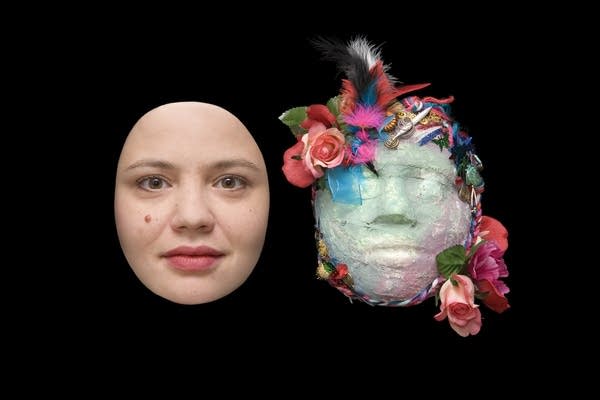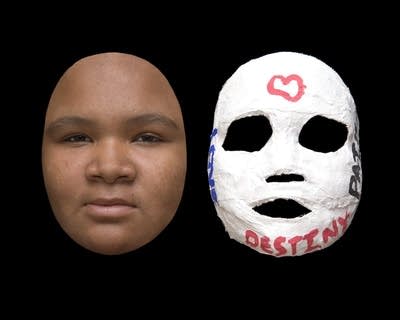What our masks reveal about ourselves

At six feet by 20 feet, Barbara Cummard's photographic mural "Inside Out: Faces of Self" is the largest image the Minnesota Center for Photography has ever hung on its walls.

Cummard created a black panel against which 140 faces and their respective masks are offset. Cummard says she's always been interested in how people present themselves to the world.
"For me, it's become clear that we are a series of constantly changing masks," she says. "You know we adopt different ways of being. We adopt clothing, we adopt hairstyles, we adopt tattoos sometime. We all have roles that we play to."
Cummard wanted to find ways for her subjects to participate in creating the art. She facilitated mask making sessions with groups of individuals in Minnesota, England, New Zealand and Australia. She worked with people with mental disabilities, immigrant workers, people in shelters, as well as neighbors, family and friends.
Create a More Connected Minnesota
MPR News is your trusted resource for the news you need. With your support, MPR News brings accessible, courageous journalism and authentic conversation to everyone - free of paywalls and barriers. Your gift makes a difference.

The contrasts between the faces and the masks are striking.
Some people seem quite expressionless, while their masks convey a world of wonder and fantasy. Other faces seem friendly and cheerful, while their masks are harsh and unnerving. Many of the masks are brightly colored and highly ornamented.
When Amy Weber sat down to make her mask a year ago, she was living at a Minneapolis halfway house where she was in recovery.
"I was needing to find a sense of self," she says. "Needing to sculpt a sense of who I am, what positive qualities I have and how I can best use those qualities to truly start to live a life that represents who I am on the inside.

Weber, who has always had an interest in art, became immediately engrossed in making a mask of her inner self. The result is a serene face in cool green, blue and pink, bordered with silk roses, beads, feathers and ribbons.
"And as you'll see right here," she says pointing, "I've got the red and the white and the blue, which is symbolic of my origin of place - I'm here in America. You'll see the spirals, the stars, the butterfly, this shiny metal - the way its encrusted up toward the mind area is indicative of thought and our mental connection. Our consciousness basically."

Weber's doing much better now. She says the mask is something she looks to for inspiration and strength. She says it's a reminder of her inner beauty. She wishes everyone would make a mask, because it would invite them to take time to be more introspective.
The mural, with its 140 faces, provokes both introspection and exclamation.
"Fascinating. Wonderful!" Professor Sears Eldredge mutters to himself.
Eldredge has traveled the world studying mask-making and mask-based theater. He taught classes on it at Macalester before he retired. Eldredge says theater professionals, when using masks, often talk about "concealing in order to reveal".

"It's really quite amazing how many different kinds of masks have been used around the world by different cultures to say something about themselves or to say something about the world which they inhabit," he says.
Eldredge says he's struck by the similarities he sees in these masks to others he's seen in Africa or Asia.
He says it's tempting to look at a mask and try to figure out what it says about a person, but that would be wrong. He says one person could create five completely different masks, and each mask might represent a different aspect of who they are or who they want to be.

Barbara Cummard agrees. She says it's really up to the individual to decide what their mask means to them.
"What I absolutely know, absolutely know, at the end of this is that every single person has this creative spark within them," she says. "Irrespective of who they are, irrespective of what they've done, what they look like, whether they've got downs syndrome or whether they've lost their memory, they all still have a creative spark within."
Barbara Cummard's piece "Inside Out: Faces of Self" is on display at the Minnesota Center for Photography through April 27th, as part of the group show "ICY." She's also created a vinyl banner of the image which is currently touring various public buildings in the Twin Cities.


